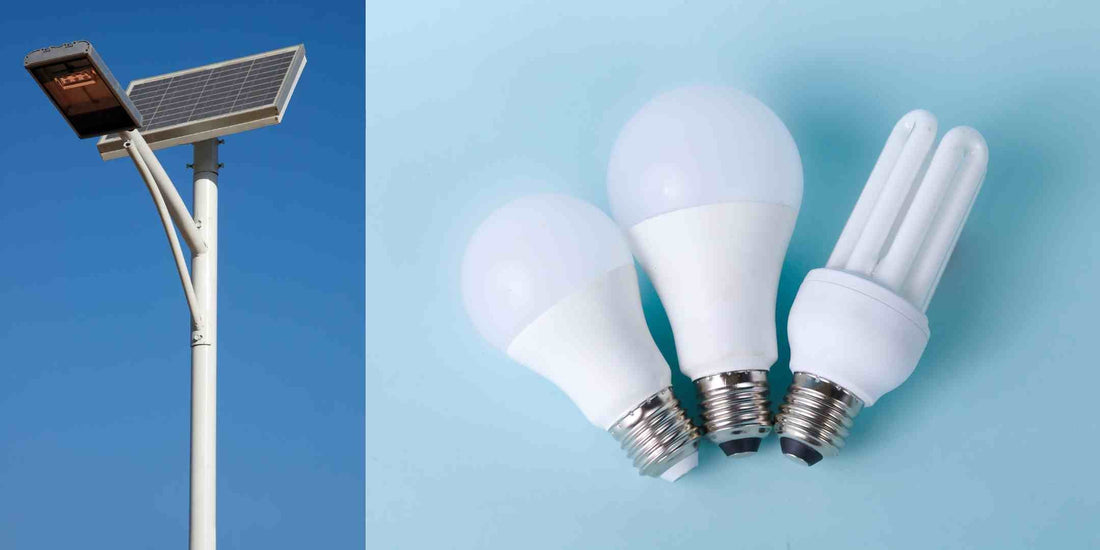
Solar Lights vs. LED: Which Is Better for Your Home?
Share
If you’ve ever wandered down the lighting aisle at your local hardware store, you’ve probably found yourself stuck between two choices: solar or LED. Both promise energy efficiency, long life, and wallet-friendly benefits—but which one is really the smarter pick for your home?
When it comes to Solar lights vs LED lights for the home, the answer isn’t one-size-fits-all. Each has perks (and a few drawbacks) depending on how you plan to use them.
Plus, the decision depends on function, placement, and, yes, your patience level.
Let’s break it down and answer some of the most common homeowner questions: “What is the difference between solar light and LED light?”, “Are LED lights safe for artwork?”, “What is the downside of solar lights?”, and “What are the advantages of LED garden lights vs solar garden lights?”
What Is the Difference Between Solar Light and LED Light?

Here’s where many homeowners get confused: solar and LED aren’t actually the same thing.
- LED (Light Emitting Diode): A versatile technology that creates efficient, long-lasting light. LEDs can be used in almost any type of fixture, offering homeowners a wide range of options for indoor, outdoor, decorative, and task-oriented applications.
- Solar Light: A system that uses LED bulbs but is powered by the sun via solar panels and a rechargeable battery.
The fundamental distinction is the power source. LEDs plug into your electrical grid (or sometimes batteries), while solar lights depend on sunlight to charge.
The Case for LED Lights
LEDs have become the gold standard in modern homes. Here’s why:
- Energy Efficiency: Up to 80% less energy utilization than incandescent bulbs.
- Long Lifespan: Many last 25,000–50,000 hours—yes, that’s years.
- Brightness Control: Wide range of brightness and color temperatures, from cozy warm to daylight-bright.
- Versatility: Works indoors, outdoors, in fixtures, lamps, art lighting, and more.
And for anyone wondering, “Are LED lights safe for artwork?”—the answer is yes. Unlike halogens or fluorescents, LEDs emit very little UV radiation and minimal heat, so they won’t damage canvases, fabrics, or photographs. That’s why galleries and museums increasingly rely on LED spotlights.
Designer’s Note: Many interior designers recommend replacing halogen track lights with warm-white LEDs, especially for displaying artwork or family photos.
The Case for Solar Lights
Solar lighting has its own undeniable appeal, especially outdoors. They are:
- Eco-Friendly
- Easy Installation
- Low Running Cost
- Perfect for Pathways & Gardens
But here’s the catch—“What is the downside of solar lights?” Well, a few things:
- Weather Dependency: No sun = weak charge = dim lights. Cloudy days are not their best friends.
- Brightness: Generally softer and less potent than wired LEDs.
- Battery Lifespan: Rechargeable batteries typically last 2–3 years before needing replacement.
Designer’s Note: Designers often caution against relying solely on solar floodlights for security. In one case, a homeowner installed them along a driveway. Still, after several rainy weeks, the lights barely turned on at night. The solution was to add wired LED motion-sensor lights for reliability, while keeping solar fixtures for decorative accent lighting.
Solar Lights vs LED Lights for Home: Which Wins Indoors?
For interiors, LEDs are the clear winner. Solar lighting is simply not practical indoors, unless you’re living in a greenhouse (and even then, cloudy days would still be an issue). LEDs provide consistent brightness, design flexibility, and safety for delicate items such as artwork and textiles.
So if your project involves kitchens, bathrooms, bedrooms, or highlighting décor, stick with LEDs.
Solar Lights vs LED Lights for Home: Which Wins Outdoors?
This is where the debate gets more interesting. Outdoor lighting has unique demands—style, safety, and functionality all come into play.
- Pathways & Gardens: Solar is often enough. Stake a few solar-powered path lights along the walkway, and you’ve got instant charm without touching a single wire.
- Security Lighting: LEDs win. You want powerful brightness and motion sensors for peace of mind.
- Accent Lighting: Both work. Solar lanterns are whimsical and eco-friendly; LED spotlights are precise and durable.
So, “What are the advantages of LED garden lights vs solar garden lights?” In a nutshell:
- LED Garden Lights: Brighter, longer-lasting, dependable regardless of weather.
- Solar Garden Lights: Affordable, sustainable, and easy to install, but less reliable on cloudy days.
Durability & Maintenance: What Lasts Longer?
When investing in fixtures, durability is a crucial factor.
- LEDs: Long-lasting, low-maintenance, and reliable across climates. They work rain or shine because they’re tied to your electrical system.
- Solar: Great initially, but battery replacement is inevitable every few years. Exposure to rain, snow, or extreme heat can also cause damage or accelerate wear and tear.
Cost Considerations
- Upfront Costs: Solar fixtures are generally more affordable and don’t require the services of an electrician. LEDs can be more expensive if wiring is needed.
- Running Costs: Solar = zero ongoing electricity cost. LEDs = a slight increase in your electric bill, but significantly less than older lighting types.
- Long-Term Value: LEDs often outlast solar due to more consistent performance and fewer battery replacements.
Designer’s Real Talk: Many interior designers recommend replacing halogen track lights with warm-white LEDs, especially for displaying artwork or family photos. In one project, photos that had started fading under halogens looked vibrant again once LEDs were installed—and the homeowners also noticed a significant drop in their electricity bill.
Aesthetics: Which Looks Better?
This one is subjective. Solar lights often come in simpler, ready-to-install designs. LEDs offer endless flexibility—sleek wall sconces, minimalist spotlights, statement chandeliers, and even hidden under-cabinet strips. If style matters as much as function, LEDs give you more creative freedom.
The Hybrid Approach: Why Not Both?
Here’s a little secret: you don’t actually have to choose. Many homeowners combine solar and LED for a balanced approach.
- Use solar for pathways, gardens, and accent features where brightness isn’t critical.
- Use LED for main outdoor areas (patios, driveways, security spots) and all indoor spaces.
That way, you save on energy costs while still ensuring reliable light where it counts.
Final Verdict: Solar or LED?

So, when it comes to Solar lights vs. LED lights for the home, the answer isn’t black and white.
- If you value consistency, durability, and a flexible design, LED is your best bet.
- If you want eco-friendly, no-fuss outdoor charm → solar lights are perfect.
- If you want the best of both worlds → mix and match.
The right choice depends on your space, your budget, and how much you’re willing to tinker. But here’s the designer’s take: don’t think of lighting as just function—think of it as part of the design story. Whether it’s a softly glowing solar lantern or a dramatic LED spotlight, the proper lighting creates the atmosphere you’ll actually want to live in.
